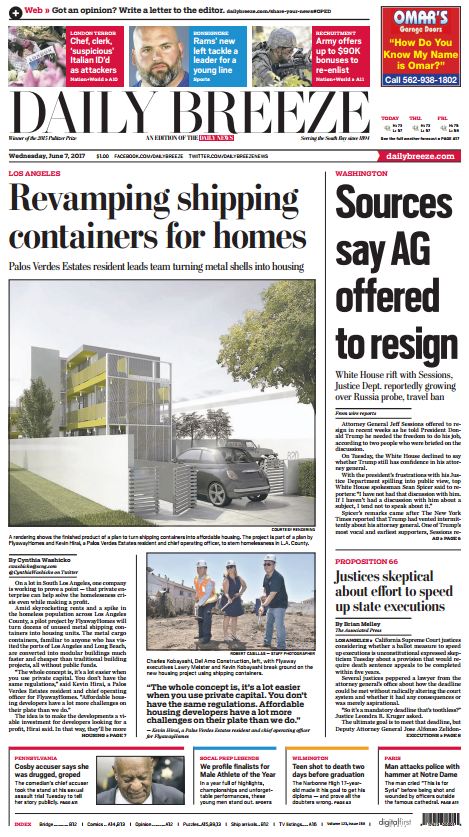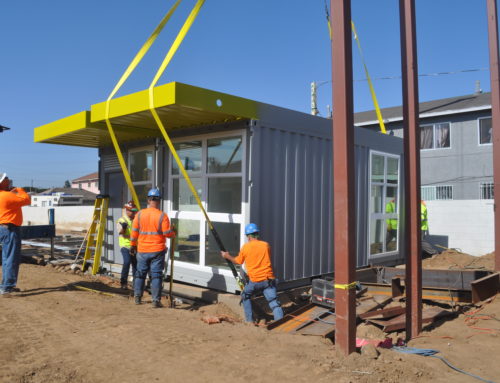


On a lot in South Los Angeles, one company is working to prove a point — that private enterprise can help solve the homelessness crisis even while making a profit.
Amid skyrocketing rents and a spike in the homeless population across Los Angeles County, a pilot project by FlyawayHomes will turn dozens of unused metal shipping containers into housing units. The metal cargo containers, familiar to anyone who has visited the ports of Los Angeles and Long Beach, are converted into modular buildings much faster and cheaper than traditional building projects, all without public funds.
“The whole concept is, it’s a lot easier when you use private capital. You don’t have the same regulations,” said Kevin Hirai, a Palos Verdes Estates resident and chief operating officer for FlyawayHomes. “Affordable housing developers have a lot more challenges on their plate than we do.”
The idea is to make the developments a viable investment for developers looking for a profit, Hirai said. In that way, they’ll be more likely to pour their dollars into similar projects, and create more opportunities to help homeless people move off the streets, he said.
A new take
The plan is a dramatic departure from traditional permanent supportive housing developments, which pair affordable housing with supportive services designed to keep tenants in their homes and help with any mental, physical or other issues they might have.
FlyawayHomes isn’t the first to turn containers into housing. American Family Housing, an Orange County-based nonprofit, recently opened Potters Lane, a 16-unit apartment complex made with the metal vessels to offer affordable housing to homeless veterans.
Funding the project entirely with private equity, however, makes it unique, in particular for a project targeting chronically homeless and disabled people, said John Maceri, executive director for The People Concern, which will provide the supportive services at the FlyawayHomes site.
“What that does is it lowers the cost per unit and also the time frame for construction,” Maceri said.
Normally, such developments take years to complete and cost hundreds of thousands of dollars per unit, partially because they rely on public grants and funds, Maceri said.
The FlyawayHomes model, however, eliminates the bureaucratic element of using public funds, replacing it with private equity.
The company broke ground on its first project May 22, and the entire building on Colden Avenue is scheduled to be completed by November, which Hirai called a vast improvement over how long traditional building projects take.
Easy to re-create
A key element of the project is the use of premade shipping containers — similar to those that come and go at the ports of Los Angeles and Long Beach — to form the skeleton of the building, Hirai said.
The containers are refurbished by L.A.-based GrowthPoint Structures, which turns them from 20-by-8-foot metal shells into livable spaces with plumbing and electrical systems, insulation and windows.
The FlyawayHomes project will include eight fourbedroom units, each with one bathroom, as well as a unit for the building manager.
Once the containers are completed, the entire building can be welded together to create a new complex. And it has the potential to go up wherever there’s space to put up a new building, Hirai said.
All it takes is for the company to buy the necessary shipping containers, put them together in place and open the building for residents.
“It’s essentially like ordering another Lego set,” he said.
Growing need
The plan grew out of a committee on permanent supportive housing at The People Concern. Hirai, who was a member of the committee, said the group spent the past five years developing the idea.
They knew that some of The People Concern’s clients received just $550 a month, so the challenge was to work backward from there to create a housing option that would fit in that budget.
“That’s sort of the main challenge, matching the development costs with the resources that our clients have,” Hirai said.
Los Angeles is facing a housing crisis, and people with fixed or low incomes have been hit hardest by spikes in rent and a lack of available space, Maceri said.
Median rents in L.A. increased by 32 percent since 2000, according to a report by the Southern California Association of Non-Profit Housing. And the city now needs more than 551,000 additional rental homes to meet the demands of its low-income renters, according to the report.
Additionally, homelessness in the county has spiked by 23 percent since 2016, according to recently released results of the 2017 Great Los Angeles Homeless Count by Los Angeles Homeless Services Authority. The report listed rising housing costs and a tight rental market as some of the factors that led to the jump.
Following the release of the results, city leaders renewed their call for a dramatic increase in the amount of affordable housing.
“ Families are being pushed out onto the streets by rising rents,” Los Angeles Councilman Joe Buscaino said in a video on his Facebook page.
‘Beginning of the shift’
Aside from the physical building, the services provided for tenants is largely the same as in other permanent supportive housing, Maceri said, which makes the FlyawayHomes system flexible enough to be scaled up or down depending on available space.
“I think it’s something that will catch on as … other developers begin to recognize that there are ways to approach this that don’t necessarily follow the traditional financing model,” Maceri said.
And he sees the project as part of a new trend in how the issue of creating affordable housing and combating homelessness can be addressed.
“I think we are really at the beginning of the shift … in terms of thinking about, how do you build more housing generally, and particularly more housing for homeless people that is scalable, sustainable, less expensive and takes less time,” Maceri said.


